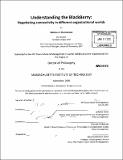Understanding the BlackBerry : negotiating connectivity in different organizational worlds
Author(s)
Mazmanian, Melissa A
DownloadFull printable version (18.56Mb)
Other Contributors
Sloan School of Management.
Advisor
JoAnne Yates and Wanda Orlikowski.
Terms of use
Metadata
Show full item recordAbstract
This research challenges the popular conception that BlackBerry use is solely an individual phenomenon. Email is social. People use and experience the potential for wireless email in terms of their occupational identity, daily work practices and organizational context. I collected longitudinal qualitative data from the in-house legal counsel and U.S. mobile sales in a mid-sized footwear and apparel company to understand the process through which people experience wireless email over time. I examined how each group engaged with the BlackBerry from its introduction to over three years of use. My inductive study reveals how initial technological frames inform, but do not determine, emerging patterns of BlackBerry use and how such frames can shift dramatically over time. Further, I trace how individual experience evolves into shared norms that carry significant personal consequences for group members. I unpack how BlackBerry users in the legal team shaped the potential for constant access into a form of social constraint, while BlackBerry users the sales force embraced expanded access to email as enabling increased autonomy and personal time. This work contributes to current research on communication in the digital age by highlighting key dimensions such as anticipated expectations of clients, peers and superiors, as well as the alignment between occupational identity and constant availability, that influence how users take up the potential for ubiquitous email. This research suggests a number of implications for the evolution of work practices, temporal structures, and ramifications of constant connectivity in the modern workplace.
Description
Thesis (Ph. D.)--Massachusetts Institute of Technology, Sloan School of Management, 2009. Cataloged from PDF version of thesis. Includes bibliographical references (p. 227-234).
Date issued
2009Department
Sloan School of ManagementPublisher
Massachusetts Institute of Technology
Keywords
Sloan School of Management.